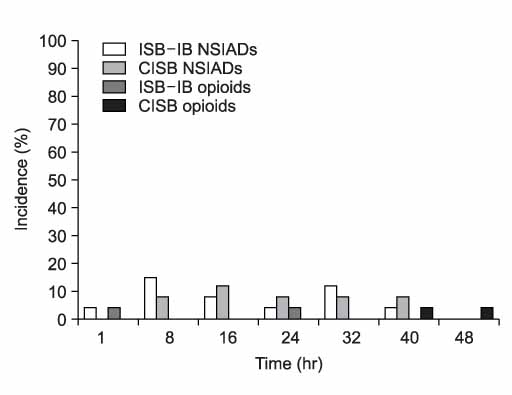Clin Orthop Surg.
2009 Mar;1(1):48-53. 10.4055/cios.2009.1.1.48.
Comparison of Analgesic Efficacy between Single Interscalene Block Combined with a Continuous Intra-bursal Infusion of Ropivacaine and Continuous Interscalene Block after Arthroscopic Rotator Cuff Repair
- Affiliations
-
- 1Department of Orthopaedic Surgery, Seoul National University College of Medicine, Korea.
- 2Department of Anesthesiology and Pain Medicine, Konkuk University School of Medicine, Korea. rheeky@kuh.ac.kr
- 3Department of Anesthesiology and Pain Medicine, Seoul National University College of Medicine, Seoul, Korea.
- 4Department of Radiology, Seoul National University College of Medicine, Seoul, Korea.
- KMID: 1127914
- DOI: http://doi.org/10.4055/cios.2009.1.1.48
Abstract
-
BACKGROUND: This study evaluated the effectiveness of a continuous interscalene block (CISB) by comparing it with that of a single interscalene block combined with a continuous intra-bursal infusion of ropivacaine (ISB-IB) after arthroscopic rotator cuff repair.
METHODS
Patients who had undergone CISB (CISB group; n = 25) were compared with those who had undergone ISB-IB (ISB-IB group; n = 25) for more than 48 hours after surgery. The visual analog scale (VAS) for pain, motor and/or sensory deficit, supplementary analgesics and adverse effects were recorded.
RESULTS
There were no significant differences between the postoperative VAS of the CISB and ISB-IB groups, except at 1 hour after surgery. Their supplementary analgesics of the two groups were similar. Transient motor weakness (52%) and sensory disturbance (40%) of the affected arm were observed in patients in the CISB group. The catheters came out accidentally in 22% of the CISB group but in only 4% of the ISB-IB group.
CONCLUSIONS
ISB-IB provides similar analgesia to CISB. However, the ISB-IB group had a lower incidence of neurological deficits and better catheter retention.
Keyword
MeSH Terms
-
Adult
Aged
Amides/*administration & dosage
Analgesia/*methods
Anesthetics, Local/*administration & dosage
Arthroscopy
Bursa, Synovial
Case-Control Studies
Female
Humans
Infusions, Intralesional
Male
Middle Aged
*Nerve Block
Pain Measurement
Pain, Postoperative/*prevention & control
Prospective Studies
Rotator Cuff/*surgery
Shoulder Joint/surgery
Figure
Cited by 1 articles
-
Effect of a Sleep Aid in Analgesia after Arthroscopic Rotator Cuff Repair
Chul-Hyun Cho, Si-Wook Lee, Young-Kuk Lee, Hong-Kwan Shin, Ilseon Hwang
Yonsei Med J. 2015;56(3):772-777. doi: 10.3349/ymj.2015.56.3.772.
Reference
-
1. Bishop JY, Sprague M, Gelber J, et al. Interscalene regional anesthesia for shoulder surgery. J Bone Joint Surg Am. 2005. 87(5):974–979.
Article2. Borgeat A, Schäppi B, Biasca N, Gerber C. Patient-controlled analgesia after major shoulder surgery: patient-controlled interscalene analgesia versus patient-controlled analgesia. Anesthesiology. 1997. 87(6):1343–1347.3. Oh JH, Kim WS, Kim JY, Gong HS, Rhee KY. Continuous intralesional infusion combined with interscalene block was effective for postoperative analgesia after arthroscopic shoulder surgery. J Shoulder Elbow Surg. 2007. 16(3):295–299.
Article4. Barber FA, Herbert MA. The effectiveness of an anesthetic continuous-infusion device on post-operative pain control. Arthroscopy. 2002. 18(1):76–81.
Article5. Klein SM, Nielsen KC, Martin A, et al. Interscalene brachial plexus block with continuous intraarticular infusion of ropivacaine. Anesth Analg. 2001. 93(3):601–605.
Article6. Jensen MP, Chen C, Brugger AM. Interpretation of visual analog scale ratings and change scores: a reanalysis of two clinical trials of postoperative pain. J Pain. 2003. 4(7):407–414.
Article7. Mallon WJ, Thomas CW. Patient-controlled lidocaine analgesia for acromioplasty surgery. J Shoulder Elbow Surg. 2000. 9(2):85–88.
Article8. Muittari P, Kirvelä O. The safety and efficacy of intrabursal oxycodone and bupivacaine in analgesia after shoulder surgery. Reg Anesth Pain Med. 1998. 23(5):474–478.
Article9. Nisar A, Morris MW, Freeman JV, Cort JM, Rayner PR, Shahane SA. Subacromial bursa block is an effective alternative to interscalene block for postoperative pain control after arthroscopic subacromial decompression: a randomized trial. J Shoulder Elbow Surg. 2008. 17(1):78–84.
Article10. Savoie FH, Field LD, Jenkins RN, Mallon WJ, Phelps RA 2nd. The pain control infusion pump for postoperative pain control in shoulder surgery. Arthroscopy. 2000. 16(4):339–342.
Article11. Scoggin JF 3rd, Mayfield G, Awaya DJ, Pi M, Prentiss J, Takahashi J. Subacromial and intra-articular morphine versus bupivacaine after shoulder arthroscopy. Arthroscopy. 2002. 18(5):464–468.
Article12. Beaudet V, Williams SR, Tétreault P, Perrault MA. Perioperative interscalene block versus intra-articular injection of local anesthetics for postoperative analgesia in shoulder surgery. Reg Anesth Pain Med. 2008. 33(2):134–138.
Article13. Tuominen M, Pitkänen M, Rosenberg PH. Postoperative pain relief and bupivacaine plasma levels during continuous interscalene brachial plexus block. Acta Anaesthesiol Scand. 1987. 31(4):276–278.
Article14. Borgeat A, Dullenkopf A, Ekatodramis G, Nagy L. Evaluation of the lateral modified approach for continuous interscalene block after shoulder surgery. Anesthesiology. 2003. 99(2):436–442.
Article15. Horlocker TT, O'Driscoll SW, Dinapoli RP. Recurring brachial plexus neuropathy in a diabetic patient after shoulder surgery and continuous interscalene block. . Anesth Analg. 2000. 91(3):688–690.
Article16. Souvatzoglou R, Gampopoulou Z, Aggelaki K, et al. Continuous interscalene nerve blockade versus continuous subacromial administration of ropivacaine for postoperative pain management in shoulder surgery. Reg Anesth Pain Med. 2007. 32(5 Suppl 1):137.
Article17. Bettmann MA. Contrast media: safety, viscosity, and volume. Eur Radiol. 2005. 15:Suppl 4. D62–D64.
Article18. Ilfeld BM, Morey TE, Wright TW, Chidgey LK, Enneking FK. Continuous interscalene brachial plexus block for postoperative pain control at home: a randomized, double-blinded, placebo-controlled study. Anesth Analg. 2003. 96(4):1089–1095.
Article19. Delaunay L, Souron V, Lafosse L, Marret E, Toussaint B. Analgesia after arthroscopic rotator cuff repair: subacromial versus interscalene continuous infusion of ropivacaine. Reg Anesth Pain Med. 2005. 30(2):117–122.
Article20. Sandefo I, Bernard JM, Elstraete V, et al. Patient-controlled interscalene analgesia after shoulder surgery: catheter insertion by the posterior approach. Anesth Analg. 2005. 100(5):1496–1498.
Article
- Full Text Links
- Actions
-
Cited
- CITED
-
- Close
- Share
- Similar articles
-
- Regional nerve blocks for relieving postoperative pain in arthroscopic rotator cuff repair
- A clinical comparison of continuous interscalene brachial plexus block with different basal infusion rates of 0.2% ropivacaine for shoulder surgery
- Infusion Methods for Continuous Interscalene Brachial Plexus Block for Postoperative Pain Control after Arthroscopic Rotator Cuff Repair
- Comparison between two different concentrations of a fixed dose of ropivacaine in interscalene brachial plexus block for pain management after arthroscopic shoulder surgery: a randomized clinical trial
- The Efficacy of Additional Intravenous Patient-controlled Analgesia to the Interscalene Block in Arthroscopic Shoulder Surgery: A Prospective Randomized Controlled Study



